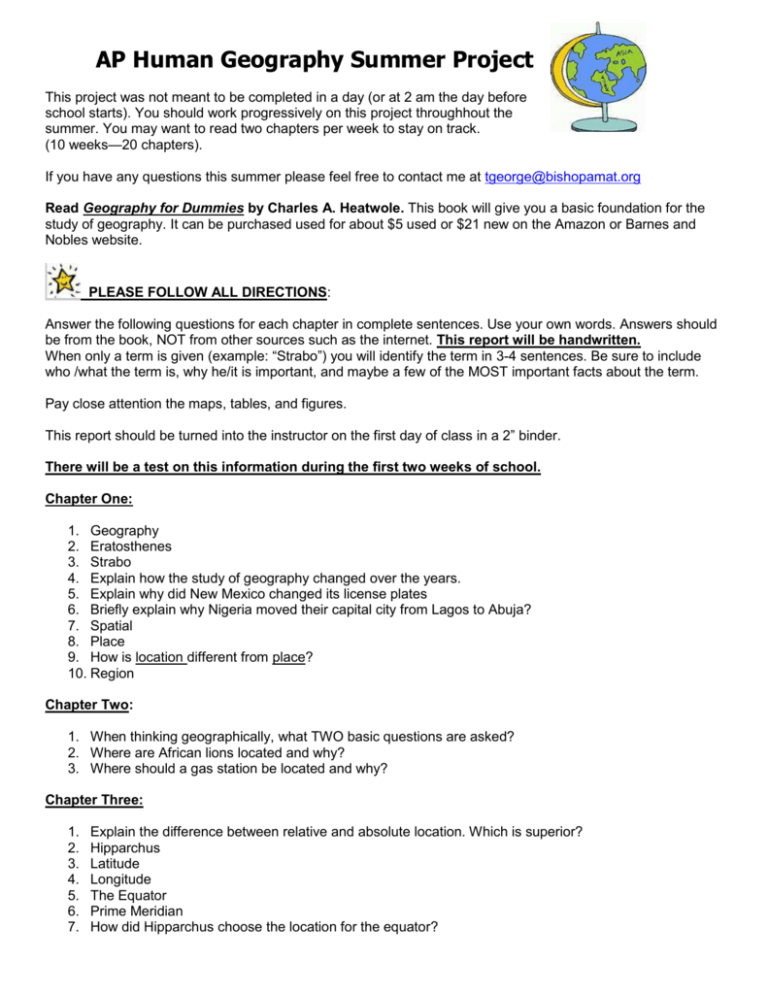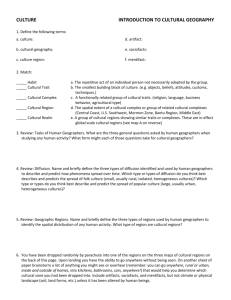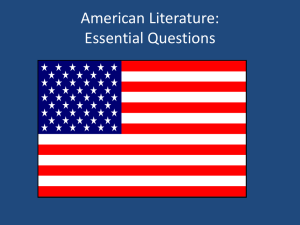AP Human Geography Summer Project
advertisement

AP Human Geography Summer Project This project was not meant to be completed in a day (or at 2 am the day before school starts). You should work progressively on this project throughhout the summer. You may want to read two chapters per week to stay on track. (10 weeks—20 chapters). If you have any questions this summer please feel free to contact me at tgeorge@bishopamat.org Read Geography for Dummies by Charles A. Heatwole. This book will give you a basic foundation for the study of geography. It can be purchased used for about $5 used or $21 new on the Amazon or Barnes and Nobles website. PLEASE FOLLOW ALL DIRECTIONS: Answer the following questions for each chapter in complete sentences. Use your own words. Answers should be from the book, NOT from other sources such as the internet. This report will be handwritten. When only a term is given (example: “Strabo”) you will identify the term in 3-4 sentences. Be sure to include who /what the term is, why he/it is important, and maybe a few of the MOST important facts about the term. Pay close attention the maps, tables, and figures. This report should be turned into the instructor on the first day of class in a 2” binder. There will be a test on this information during the first two weeks of school. Chapter One: 1. Geography 2. Eratosthenes 3. Strabo 4. Explain how the study of geography changed over the years. 5. Explain why did New Mexico changed its license plates 6. Briefly explain why Nigeria moved their capital city from Lagos to Abuja? 7. Spatial 8. Place 9. How is location different from place? 10. Region Chapter Two: 1. When thinking geographically, what TWO basic questions are asked? 2. Where are African lions located and why? 3. Where should a gas station be located and why? Chapter Three: 1. 2. 3. 4. 5. 6. 7. Explain the difference between relative and absolute location. Which is superior? Hipparchus Latitude Longitude The Equator Prime Meridian How did Hipparchus choose the location for the equator? 8. Where did the first mapmakers place the Prime Meridian? 9. Explain why Greenwich was chosen for the Prime Meridian in 1884. 10. Why did Hipprachus choose divide a circle (and the earth) into 360 degrees? 11. Who decided that the top of a map would be the direction north? 12. Parallels 13. Meridians 14. Graticule 15. Minutes 16. Seconds 17. Our system of _____________ goes back to the Sumerians based 6 arithmetic used by Hipparchus. 18. GPS 19. Explain how GPS’s are being used to save Asia’s tigers. Chapter Four: 1. Map 2. Cartography 3. Cartographer 4. Projections 5. Explain why the earth NOT a sphere. 6. Globe 7. Mercator Projection 8. Explain what happens to land near the poles on the Mercator Projection. 9. Goode’s Interrupted Projection 10. Explain why most geographers prefer the Robinson Projection. 11. Atlas Chapter Five: 1. 2. 3. 4. 5. 6. Scale Explain the three ways in which a cartographer can indicate scale. What would the RF 1: 12,362 mean? All points on the earth have an elevation with respect to: ___________ ________. Topography Explain the three ways in which a cartographer can show topographic information. You may use drawings in your explanation. Chapter Six: 1. How old is Earth? 2. Lithosphere 3. Explain the difference between a tectonic force and a gradational force. What do these “forces” have in common? 4. What is the record for penetrating the earth’s crust? 5. Alfred Wegener 6. Mid Atlantic Range 7. How fast are the tectonic plates moving? 8. Briefly explain the Theory of Plate Tectonics 9. Give three reasons why geographers are interested in mountains. 10. Explain the three processes that are responsible for mountains. You may want to use a drawing in your explanation. 11. Seismology 12. San Andreas Fault 13. Tsunamis 14. Explain how urban geographers are mitigating the impact of future tsunamis. 15. Subduction 16. The Ring of Fire 17. Hawaii 18. Lahar Chapter Seven: 1. Gradational force 2. Weathering 3. Mechanical weathering 4. Chemical weathering 5. Soil 6. Mass wasting 7. Floodplains 8. Glaciers 9. Continental glaciers 10. Loess Chapter Eight: 1. Water 2. Antarctica 3. List the four oceans 4. Desalination 5. Lake 6. Seas 7. Explain why some lakes are called “seas”. 8. Continental shelf 9. Give two reasons why the continental shelf is the most economically important part of the ocean. 10. Explain why it is important to decide how far off shore a nation’s territory extends. 11. Use bullet points to briefly describe these different zones which were created by the United Nations regarding the coasts: a. Territorial Sea b. Contiguous Zone c. Exclusive Economic Zone d. The High Seas 12. Explain what nations will be most affected by global warming and why. 13. Draw and label the water cycle. 14. Aquifer 15. Cancer cluster 16. The Ogallala Aquifer 17. Drip irrigation Chapter Nine: 1. Weather 2. Climate 3. List the six factors that cause climate to occur. 4. What is unique about the North and South Poles? 5. Windward slope 6. Leeward slope 7. Rain shadow 8. Continentality 9. Current 10. The Gulf Stream 11. El Nino 12. La Nina 13. Low pressure system 14. High pressure system 15. Monsoon 16. Cherrapunji, India Chapter 10: 1. Use bullet points to describe each of these climates: a. Tropical rainforest b. Tropical monsoon c. Savannah d. Desert e. Steppe f. Mediterranean g. Subarctic h. Tundra i. Ice Cap 2. Malaria 3. Al-Azizia Chapter Eleven: 1. 2. 3. 4. 5. The population of earth is:___ What was the population of the planet 200 years ago? Demography Asia contains ___ % of the world’s population. If a country’s birthrate is 2.5 5, how long would it take to double it’s population? What if its birthrate is .5%? 6. Use bullet points to highlight the FOUR stages of the Demographic Transition Model. Be concise! 7. Explain the views of a Neo-Malthusian and how they differ from a Cornucopian. Chapter 12: 1. 2. 3. 4. 5. 6. 7. 8. Migration Humans originated in______. Explain how it was possible for a human to walk from Florida to Cuba 60,000 years ago. Push factor Pull factor List and briefly describe barriers to migration. “Brain Drain” What areas of the USA are losing population? What areas are gaining? Chapter 13: 1. There are approximately _____ different cultures. 2. Adaption 3. Define and give an example of: a. Cultural diffusion b. Relocation diffusion c. Contiguous expansion diffusion d. Hierarchal diffusion e. Absorbing barrier effects f. Permeable barrier effects 4. List the five physical barriers that inhibit cultural diffusion. 5. How many languages are in New Guinea? How is this possible? Look for New Guinea on a map amd describe its location. 6. List the four social barriers that inhibit the spread of culture. 7. What is “Gullah”? How did it develop? Why is it disappearing? 8. Where is the religion of Islam most prevalent? 9. Toponyms 10. What is “cultural convergence” What factors are encouraging cultural convergence? Chapter 14: 1. Ethnic boundary 2. Natural boundary 3. Geometric boundary 4. There are approximately _____ nations. 5. Define and give an example of each: a. State b. Nation c. Multi-nation state d. Multi-state nation e. State-less nation 6. What is an “Act of God” Give one example. What questions arise after an “act of God”? 7. Explain the problem behind Rumaila Oil Field Crisis and the Georges Bank. How was each crisis solved? 8. What problem is faced by land-locked nations? What has been provided for these nations under international law? 9. Draw and label the four types of country shapes. What benefits/problems does each country shape have? 10. Briefly explain what “gerrymandering” is. Chapter 15: 1. Economics 2. Briefly describe the work of an economic geographer. 3. List and briefly explain the FOUR types of economic activities. Use bullet points: a. Primary activities b. Secondary activities c. Tertiary activities d. Quaternary activities 4. Subsistence economy 5. Commercial economy 6. Planned economy 7. Location factor 8. List and briefly explain factors that a business will look at before choosing a site for business. Use bullet points if you like. 9. Look at Figure 15-9. Make a chart of the states with the 15 highest tax rates and the 15 lowest tax rates 10. What is an “enterprise zone”? Why would a state create one? Chapter 16: 1. Natural resource 2. Non-renewable energy sources 3. The world has a _____ year supply of oil, a _____ year supply of coal, and a ____ year supply of natural gas. 4. Gasonol 5. Renewable sources 6. Perennial sources 7. Look at Figure 16-8. From this chart, make some general statements about world energy consumption. Chapter 17: 1. 2. 3. 4. 5. 6. Today, ____ % of Americans live in an urban environment. According to Table 17-1, what city is the largest Metropolitan Area in the world today? Primate city List the five regions where the first cities developed. What is the most important prerequisite for the development and growth of cities? List and define the four factors that encourage the development of a city at a particular site. Give an example of each factor. 7. CBD 8. Ethnic neighborhoods 9. Residential areas 10. Ghettoes 11. Decentralization 12. Gentrification 13. Explain what an “Urban Heat Island” is and the factors that help create it. Chapter 18: 1. Explain the environmental impact that sewer treatment centers and agricultural activity had on Chesapeake Bay. 2. Environmental geography 3. Acid rain 4. Global warming 5. Greenhouse effect 6. ANWR Chapter 19: 1. Briefly describe the work done by: a. APFU b. AAG c. NGS d. NOAA Chapter 20: 1. Read Chapter 20. If you had to choose one of these geographically related occupations, which one would it be and why? Chapter 21: 1. Explain what geographers discovered about the “Bermuda Triangle”. 2. Explain why Alaska’s motto, “Land of the Midnight Sun” is misleading. 3. California calls itself, “The Golden State”. The governor is looking for a new title to encourage tourism to California. What new titles do you offer him? Conclusion: 1. Give a brief review of this book. Did you love it or hate it and why? What advice would you give the author? Did you learn a lot or no? What parts did you find most interesting? What made you snooze…..?






